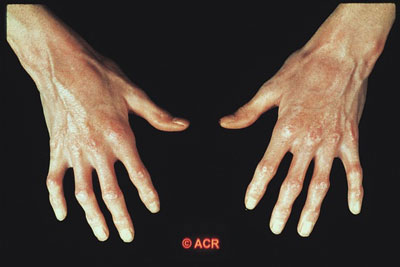Scleroderma is a chronic connective tissue disease characterized by excessive collagen deposits in the skin or other organs. This causes the skin to harden reducing mobility while giving off a reddish scaly appearance. It is a very painful disease affecting skin sensitivity. With regard to the musculoskeletal system, Scleroderma causes joint pains, which can lead to arthritis and painful ulcers on the fingers. Scleroderma also affects pulmonary function. Patients may develop pulmonary hypertension or elevation, which can be progressive and lead to right-sided heart failure. In addition, Scleroderma reduces mobility in the gastro-intestinal tract, most commonly manifested in the esophagus, which can result in a narrowing of the esophagus inhibiting breathing and swallowing. Although Scleroderma is not necessarily a fatal disease, a dangerous complication called Scleroderma Renal Crisis can be. Approximately 10% of Scleroderma patients develop SRC, which causes high blood pressure, organ damage and kidney failure. Without treatment, including ACE inhibitors and renal transplantation, SRC can be fatal.
The cause of Scleroderma has not been discovered. It is not a genetic disease or linked to any genetic predisposition although scientists have discovered a proclivity in some patients for autoimmune disease which affects the course and severity of Scleroderma.
There is no cure for Scleroderma but there are treatments for certain symptoms. Medication is available for digital ulcers and pulmonary hypertension. Immunosuppressant drugs have been shown to slow the disease while non-steroidal anti-inflammatory drugs can ease suffering.

March 29, 2008 at 7:08 pm
John,
My sister also suffers from Scleroderma, and I want to thank you for raising awareness of this disease. Your tribute/hiking adventure is truly admirable. May the wind be at your back and the sun on your shoulder. Best of luck and EVER TRUE!